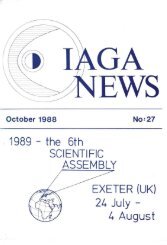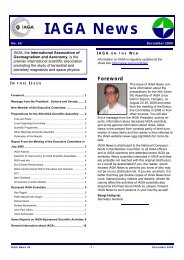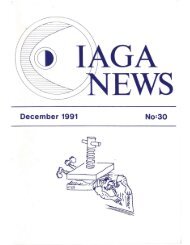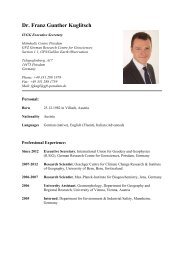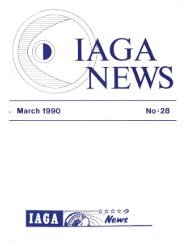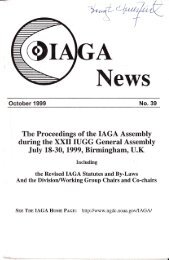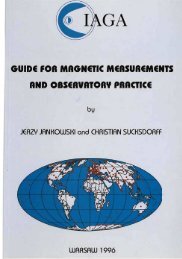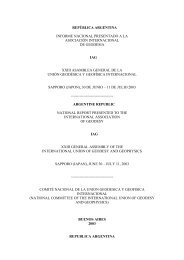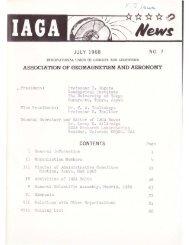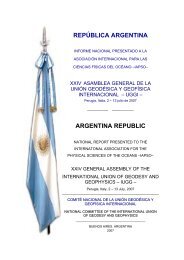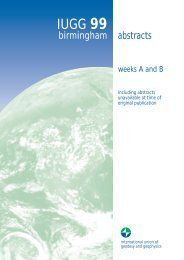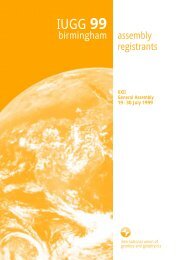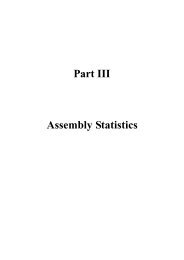IAGA News 2011 - IUGG
IAGA News 2011 - IUGG
IAGA News 2011 - IUGG
You also want an ePaper? Increase the reach of your titles
YUMPU automatically turns print PDFs into web optimized ePapers that Google loves.
5.2 <strong>IAGA</strong> guides<br />
<strong>IAGA</strong> has published four practical guides to observation.<br />
These may be ordered from the Secretary General and<br />
they are also available at the <strong>IAGA</strong> web site.<br />
<strong>IAGA</strong> Guide for Magnetic Measurements and Observatory<br />
Practice<br />
by J. Jankowski and C. Sucksdorff, 1996, 232 pages,<br />
ISBN: 0-9650686-2-5; Price: USD 50.<br />
This Guide provides comprehensive<br />
information about how<br />
to organize and run a magnetic<br />
observatory and make magnetic<br />
measurements. The main<br />
topics are:<br />
• A brief description of<br />
themagneticfieldofthe<br />
Earth<br />
• Selection of observatory<br />
sites and layout<br />
• Magnetometers<br />
• Absolutemagneticmeasurements<br />
• Recording of magnetic<br />
variations<br />
• Data processing<br />
• Testing and calibrating<br />
instruments<br />
<strong>IAGA</strong> Guide for Magnetic Repeat Station Survey<br />
by L.R. Newitt, C.E. Barton, and J. Bitterly, 1997, 120<br />
pages, ISBN: 0-9650686-1-7; Price: USD 25.<br />
Imprint<br />
Executive Editor: M.Mandea (CNES)<br />
Layout by LATEX & A.Jordan (GFZ German Research Centre for Geosciences)<br />
This Guide provides a comprehensive description of the<br />
theoretical basis, operational details, and instrumentation<br />
for making magnetic repeat station survey measurements.<br />
This manual and instruction<br />
book was written by a group<br />
of active researchers, both professional<br />
and amateur. There<br />
are chapters giving practical<br />
advice for taking visual observations,<br />
photographing the<br />
clouds with film or with video<br />
equipment. A summary of observations<br />
from space is included,<br />
as well as comments on<br />
the connection between noctilucent<br />
clouds, seen from the<br />
ground, and the polar mesospheric clouds that so far have<br />
been measured only from orbit. Noctilucent clouds are<br />
seen in the summer months, shining in the poleward sky<br />
at night-time. Measurements show that the clouds are<br />
higher than any others. Lying at a height of 80-85 kilometres,<br />
the clouds mark a boundary between meteorology<br />
and space physics. This book is beautifully illustrated<br />
with photographs, and will help everyone recognize and<br />
appreciate these “sailors in the summer night”.<br />
This guide is out of print but it is available at the web site<br />
using the link ONC. (Prices do not include shipping and<br />
handling.)<br />
5.3 <strong>IAGA</strong> web<br />
Information on <strong>IAGA</strong> can be found at:<br />
http://www.iugg.org/<strong>IAGA</strong><br />
5.4 <strong>IAGA</strong> contact<br />
The Secretary-General is the main point of contact for all<br />
matters concerning <strong>IAGA</strong>:<br />
Mioara Mandea<br />
CNES<br />
Direction de la Stratégie et des Programmes<br />
2, Place Maurice Quentin<br />
75039 Paris Cedex 01<br />
France<br />
email: iaga sg@gfz-potsdam.de<br />
<strong>IAGA</strong> <strong>News</strong> <strong>2011</strong> – Page 13



